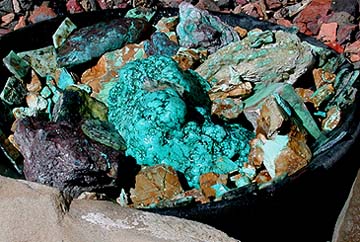Turquoise Gemstone of Centuries
Posted by Dillon Hartman on May 5th 2016

Turquoise has been one of the most desirable and popular gemstones since the times of the Egyptian pharaohs and Anasazi Indians. Turquoise is an opaque, blue-to-green mineral that is a hydrous phosphate of copper and aluminium, with the chemical formula CuAl6(PO4)4(OH)84H2O. It is rare and valuable in finer grades and has been prized as a gem and ornamental stone for thousands of years owing to its unique hue. In recent times, turquoise, like most other opaque gems, has been devalued by the introduction of treatments, imitations, and synthetics onto the market.
The substance has been known by many names, but the word turquoise, which dates to the 16th century, is derived from an Old French word for "Turkish", because the mineral was first brought to Europe from Turkey, from the mines in historical Khorasan Province of Persia. Pliny referred to the mineral as callais, the Iranians named it "firouzeh" and the Aztecs knew it as chalchihuitl
The pastel shades of turquoise have endeared it to many great cultures of antiquity: it has adorned the rulers of Ancient Egypt, the Aztecs (and possibly other Pre-Columbian Mesoamericans), Persia, Mesopotamia, the Indus Valley, and to some extent in ancient China since at least the Shang Dynasty.[9] Despite being one of the oldest gems, probably first introduced to Europe (through Turkey) with other Silk Road novelties, turquoise did not become important as an ornamental stone in the West until the 14th century, following a decline in the Roman Catholic Church's influence which allowed the use of turquoise in secular jewellery. It was apparently unknown in India until the Mughal period, and unknown in Japan until the 18th century. A common belief shared by many of these civilizations held that turquoise possessed certain prophylactic qualities; it was thought to change colour with the wearer's health and protect him or her from untoward forces.

The Aztecs inlaid turquoise, together with gold, quartz, malachite, jet, jade, coral, and shells, into provocative (and presumably ceremonial) mosaic objects such as masks (some with a human skull as their base), knives, and shields. Natural resins, bitumen and wax were used to bond the turquoise to the objects' base material; this was usually wood, but bone and shell were also used. Like the Aztecs, the Pueblo, Navajo and Apache tribes cherished turquoise for its amuletic use; the latter tribe believe the stone to afford the archer dead aim. Among these peoples turquoise was used in mosaic inlay, in sculptural works, and was fashioned into toroidal beads and freeform pendants. The Ancestral Puebloans (Anasazi) of the Chaco Canyon and surrounding region are believed to have prospered greatly from their production and trading of turquoise objects. The distinctive silver jewelry produced by the Navajo and other Southwestern Native American tribes today is a rather modern development, thought to date from circa 1880 as a result of European influences.
In Persia, turquoise was the de facto national stone for millennia, extensively used to decorate objects (from turbans to bridles), mosques, and other important buildings both inside and out, such as the Medresseh-I Shah Husein Mosque of Isfahan. The Persian style and use of turquoise was later brought to India following the establishment of the Mughal Empire there, its influence seen in high purity gold jewellery (together with ruby and diamond) and in such buildings as the Taj Mahal.
Turquoise Lore and Spiritual Beliefs
Modern Spiritualists consider Turquoise to be a stone of spiritual attunement, cleansing, protection and prosperity and a symbol of the Earth and sky, good fortune and success. The Turquoise Spiritual powers aid in some of the most common needs us humans have.
Most ancient cultures believed some form of the following about Turquoise:
Protection - Spiritualists say its change of color from dark to light to its ability to detect poisons, danger, infidelity or sickness. This myth has survived to modern times. It is an excellent token of protection for physical and astral travel and vision quests, during which it acts as a grounding force, strengthening the user against fear of the unknown by enhancing one’s feelings of trust, kindness, wisdom and understanding. It can ward off strong negativity and protect from the evil eye, reptile bites and diseases of the eye. Further, Shamans extend its protective powers to one’s property.
Superstitions - Some believe you should avoid wearing turquoise that belongs to a deceased person or that it takes on characteristics of the wearer.
Gender of the Stone - Turquoise is androgynous with a good balance of yin and yang.
Attunement - New Age followers believe Turquoise attunes the physical to the higher realms, balances the mind and soul and connects with all life. Some cultures consider it a bridge between heaven and Earth.
Good Luck - Having seen the reflection of the new moon in a stone of Turquoise, a person was believed to encounter good luck soon, according to Persian lore. Arabian superstition said it was a lucky stone and that it had good powers of benevolence. They also attributed the accumulation of wealth and prosperity with the stone.
For more information visit IndianVillage.com's page on Turquoise Spiritual Beliefs
Learn about Turquoise Jewelry
Visit Durango Silver's Turquoise Jewelry Facts Page | Learn more about Turquoise
